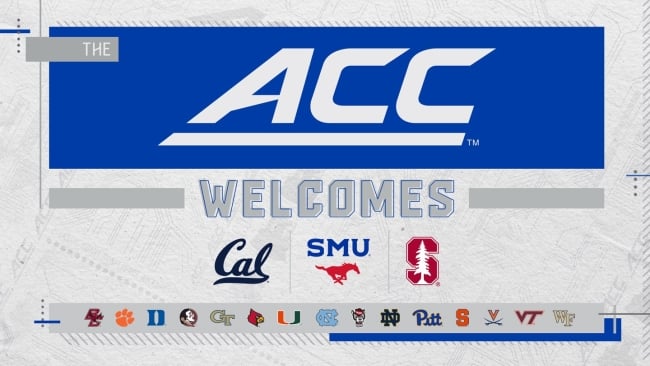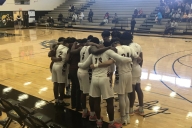You have /5 articles left.
Sign up for a free account or log in.

The Atlantic Coast Conference boasts about its new members, two of which signal the likely end of the Pac-12.
Atlantic Coast Conference
The Atlantic Coast Conference made an aggressive move Friday to preserve its status as a major college football league, in part by putting what appears to be the final dagger in the heart of the Pacific-12 Conference, effectively dissolving the Power Five.
Twelve of 15 presidents of the universities in the Atlantic Coast voted to add Southern Methodist University, Stanford University and the University of California, Berkeley, to the conference. The presidents of Clemson and Florida State Universities and the University of North Carolina at Chapel Hill voted no, even though the new members had agreed to either forgo or accept reduced amounts of conference revenue to ease some current members’ concerns about diluting their own shares. (Note: This article has been updated from an earlier version to correct the number of ACC presidents who voted.)
The ACC, which as recently as 20 years ago had nine members in six states from Maryland to Florida, will now stretch from Boston to California’s Bay Area, and as far south as Florida and Texas. Like its peers in the Big Ten and Big 12 Conferences (which come 2024 will have 18 and 16 members, respectively), the Atlantic Coast probably needs a name change.
The ACC’s move on Friday comes just four weeks after the Big Ten and Big 12 took their own bites out of the Pac-12, with the Universities of Oregon and Washington heading to the Big Ten Conference and Arizona State University and the Universities of Arizona and Utah to the Big 12.
As of today, Oregon State and Washington State Universities are the last two members standing in the Pac-12, and while the 108-year-old league might still survive in some form—perhaps by merging with another conference or raiding a lesser league—it’s unlikely to be seen as a big-time football conference peer of the ACC, Big Ten, Big 12 and Southeastern Conferences.
Much of the conversation about the latest round of conference reshuffling has focused on the competitive landscape on the football field, the impact of the rejiggered conferences on other sports and athletes (especially the likely toll cross-country travel might take on players), and which conferences will be poised to get the biggest television contracts. Those issues are not unimportant, but they are the province of ESPN and the legions of passionate sports journalists and football bloggers.
Inside Higher Ed is much more interested in the legal and political issues that could flow from this fall’s acceleration of trends that have been unfolding in and around big-time college sports for two decades:
- Greater willingness of college and university leaders to prioritize the pursuit of television dollars (to sustain the ever-increasing budgets of their sports programs) over historical relationships with peers and the well-being of athletes who increasingly crisscross the country to play conference peers.
- The growing consolidation of power by an ever-smaller number of universities in big-time football and their disinclination to keep revenue for themselves.
- Increasing tension between those trends and the insistence of college players (and their advocates) for athletes to share in the wealth and be treated as workers, not students participating as amateurs in an educational activity.
A decade ago, Inside Higher Ed published an article, based on interviews with numerous longtime observers of college sports, asserting that transformative change in higher education was unlikely without the impact of a series of “asteroids” that could propel it from the outside (since the current structure benefits colleges, boosters, television networks and other major participants in it).
At least some of those situations have unfolded since then.
For instance, referring to a flurry of conference realignment and consolidation occurring at that time, we wrote,
“At times in recent months, the situation has seemed momentous enough and uncontrollable enough … that it could lead to an outcome that has hung over the NCAA for literally decades: that a few dozen universities, tired of being constrained in their ambition and spending by the association’s less-wealthy members, could form themselves into a handful of ‘superconferences,’ create their own national football playoff system, and possibly even peel away from the NCAA and create their own basketball tournament, destroying the NCAA’s gold-plated chief asset in the process.”
The four emerging superconferences haven’t opted to pull away from the NCAA (yet) or start their own basketball tournament, although predictions abound that the top programs will align in some kind of “premier league” that would leave their peers behind. Much of the rest of this has come to pass, and the future of the College Football Playoff has been directly linked to the status of the conference realignment.
The 2012 article also envisioned the possibility of legal challenges to the NCAA’s treatment of athletes as amateurs. It said,
“Charles Clotfelter, an economist at Duke University and author of the 2010 book Big-Time Sports in American Universities, says a ruling against the NCAA in pending lawsuits challenging its use of athletes’ likenesses, for instance, could undermine the longstanding argument that athletes are amateurs and, with it, alter the financial underpinnings of major college sports.”
Indeed, court rulings against the National Collegiate Athletic Association forced the association to allow some payments to athletes and have created a Wild West environment of a patchwork of state laws that are largely reinforcing the growing divide between haves and have-nots in college sports.
The NCAA has not gone as far as many advocates for athletes believe it should, but more threats loom that could further undermine any pretense that athletes in big-time football and basketball (at least) are amateurs.
Johnson v. NCAA, a lawsuit currently winding through the courts, may ultimately decide whether college athletes should be considered employees under the Fair Labor Standards Act. While plaintiffs have argued that they should be considered employees, the NCAA contends that Department of Labor guidelines prohibit college athletes from being considered as such.
The National Labor Relations Board has also argued that college athletes should be considered employees in a complaint filed against the NCAA, the University of Southern California and the Pac-12 Conference (which, as noted above, USC is leaving). A hearing on the NLRB complaint is scheduled for November, and a decision against the NCAA could result in the classification of athletes as employees and open the door to unionization, radically altering the landscape of college sports.
Athletes being deemed employees rather than students could open colleges to a wide range of additional costs, such as workers’ compensation benefits.
Antitrust Issues
Another risk for college sports is further scrutiny on antitrust grounds. In an article in Sportico (subscription required), summarized on Yahoo, Michael McCann, one of the more thoughtful sports law analysts, argued that the protection many sports leagues (unlike the NCAA) have had to set limits on athletes’ compensation could be at risk because of the conference consolidation.
McCann, professor of law and director of the Sports and Entertainment Law Institute at the University of New Hampshire’s Franklin Pierce School of Law, noted that in the Supreme Court’s 2021 decision undermining the NCAA’s ability to limit athlete pay, Justice Neil Gorsuch said that only the “NCAA and multiconference agreements” were problematic. Gorsuch cleared the way for individual conferences to restrict athletes’ compensation, McCann said, because they compete with each other and treat athletes differently.
But that distinction could disappear, McCann suggested, as the number of major conferences shrinks, and especially if three or four big conferences band together and set common rules for football in the same way that the NCAA does in other sports.
“Would the Supreme Court feel as certain about conference competition if the Power Five became the Power Four or the Power Three?” he wrote. “That’s a question that could be answered in the form of an antitrust lawsuit. An athlete could challenge a conference’s restriction on compensation by arguing that conferences are no longer competitive and that major conferences have evolved into national entities that rival the NCAA.”
That’s especially so given that most of the conferences now have national footprints.
The Educational Tax Exemption
Inside Higher Ed’s 2012 article explored another possible threat to big-time colleges sports: the potential stripping of the federal tax exemption that college athletics programs enjoy because they use “amateur” athletes and are activities cloaked in their institutions’ underlying educational mission. The exemption allows much of the programs’ revenue to be accumulated tax-free, and treats the players as students receiving scholarships rather than employees getting paid.
“Critics have increasingly argued that the most visible collegiate sports do not warrant being considered part of the educational mission that justifies the tax exemption for nonprofit colleges. The NCAA provides a link between the major sports powers and hundreds of colleges and universities in Divisions I, II and III with more clearly ‘amateur’ teams and arguably gives the big-time programs cover.”
The article envisioned a future scenario (remember, this was 2012) in which conference realignment creates “four superconferences of 16 teams each,” and the leagues, “frustrated by NCAA-imposed limits … create their own playoff system … formally excludes all others,” leaving out enough colleges from enough U.S. states that their congressional representatives “step up calls … for antitrust investigations into big-time football.”
It wouldn’t just be the Maines and Wyomings and Delawares of the world left out, either, the 2012 article suggested: “It’s not hard to envision a U.S. senator with South Texas roots taking offense at the University of Houston and Rice University being left behind, or a California senator being unhappy with most members of the University of California system being left in the dust by Berkeley and UCLA … It’s also possible that a university like Rutgers or the University of Connecticut could be left out of a superconference mix, giving New Jersey’s and Connecticut’s senators reason to fume.”
The article concluded,
“In a restructured college sports landscape in which the ‘haves’ and the ‘have-nots’ are much more clearly and formally separated, it is not too farfetched to envision a group of angry members of Congress looking very differently than they historically have at the question of whether big-time sports is truly an amateur enterprise that warrants tax exemption as an educational activity.”
Has the big-time sports landscape continued to evolve (or devolve) to the point that politicians, the public or other key constituents are ready to forsake it? Hardly.
But is there is increasing evidence that, as the 2012 article suggested, some of the universities that play big-time sports will pursue their own interests to the point that they risk “kill[ing] the golden goose”?
“This has become a soulless enterprise," Michael LeRoy, the LER Professor of Labor and Employment Relations at the University of Illinois at Urbana-Champaign, told The New York Times last week. “There is no moral compass. There is no brotherhood. Now you eat off your brother’s plate and you don’t care if he goes hungry.”









